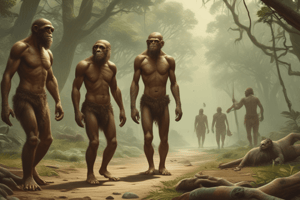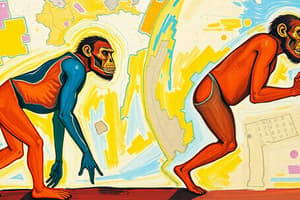Podcast
Questions and Answers
What is the main distinguishing feature of Homo habilis compared to Australopithecus?
What is the main distinguishing feature of Homo habilis compared to Australopithecus?
- Absence of tool use
- Smaller molar teeth and larger brains (correct)
- Larger body size
- Larger molar teeth
Who discovered the fossils of Homo erectus and what was the name initially given to this species?
Who discovered the fossils of Homo erectus and what was the name initially given to this species?
- Johann Carl Friedrich; Homo sapiens neanderthalensis
- Richard Leakey; Homo erectus
- Louis Leakey; Australopithecus habilis
- Eugene Dubois; Pithecanthropus erectus (correct)
What evidence suggests that Homo erectus practiced cooperative hunting?
What evidence suggests that Homo erectus practiced cooperative hunting?
- Usage of fire
- Construction of dwellings
- Bone tools and wooden spears (correct)
- Discovery of art
Which species is considered a direct evolutionary descendant of Homo erectus?
Which species is considered a direct evolutionary descendant of Homo erectus?
What are the notable features of Cro-Magnon, the early Homo sapiens?
What are the notable features of Cro-Magnon, the early Homo sapiens?
Which biological anthropologist is known for contributions to our understanding of human evolution?
Which biological anthropologist is known for contributions to our understanding of human evolution?
What is the primary focus of Palaeontology within biological anthropology?
What is the primary focus of Palaeontology within biological anthropology?
Which stage in the evolutionary history of humans is associated with the emergence of Homo sapiens?
Which stage in the evolutionary history of humans is associated with the emergence of Homo sapiens?
The term 'Homo' originates from which language?
The term 'Homo' originates from which language?
Which sub-discipline of biological anthropology focuses on the human skeletal system?
Which sub-discipline of biological anthropology focuses on the human skeletal system?
What does neuroanthropology primarily study?
What does neuroanthropology primarily study?
Which of the following statements about human evolution is correct?
Which of the following statements about human evolution is correct?
Who first used the term 'Homo' in the classification of humans?
Who first used the term 'Homo' in the classification of humans?
What does Lamarck's theory primarily focus on in terms of evolution?
What does Lamarck's theory primarily focus on in terms of evolution?
Which genus is considered the immediate forerunner of the genus Homo?
Which genus is considered the immediate forerunner of the genus Homo?
What is the primary mechanism by which Darwin explained human evolution?
What is the primary mechanism by which Darwin explained human evolution?
Which of the following processes is NOT listed as a factor in human evolution according to the synthetic theory?
Which of the following processes is NOT listed as a factor in human evolution according to the synthetic theory?
What feature distinguished Ramapithecus from other primates?
What feature distinguished Ramapithecus from other primates?
What was the primary diet of Dryopithecus as indicated in the content?
What was the primary diet of Dryopithecus as indicated in the content?
Which of the following correctly describes the physical characteristics of Australopithecus africanus?
Which of the following correctly describes the physical characteristics of Australopithecus africanus?
What does the term 'survival of the fittest' mean in the context of evolutionary theory?
What does the term 'survival of the fittest' mean in the context of evolutionary theory?
Flashcards
Paleontology
Paleontology
The study of the origin and evolution of humans through the analysis of fossil remains.
Primatology
Primatology
The scientific study of primates, including humans, focusing on their behavior, evolution, and ecology.
Neuroanthropology
Neuroanthropology
A subfield of anthropology that investigates the evolution of the human brain and the relationship between brain structure, function, and culture.
Human Osteology
Human Osteology
Signup and view all the flashcards
Evolution
Evolution
Signup and view all the flashcards
Biological Anthropologists
Biological Anthropologists
Signup and view all the flashcards
Human Evolution
Human Evolution
Signup and view all the flashcards
Linguistics
Linguistics
Signup and view all the flashcards
Homo Habilis
Homo Habilis
Signup and view all the flashcards
Homo Erectus
Homo Erectus
Signup and view all the flashcards
Neanderthals
Neanderthals
Signup and view all the flashcards
Homo Sapiens Sapiens
Homo Sapiens Sapiens
Signup and view all the flashcards
Cro-Magnon
Cro-Magnon
Signup and view all the flashcards
What is Darwinism?
What is Darwinism?
Signup and view all the flashcards
What is Lamarckism?
What is Lamarckism?
Signup and view all the flashcards
What is the Primate Order?
What is the Primate Order?
Signup and view all the flashcards
Who is Ramapithecus?
Who is Ramapithecus?
Signup and view all the flashcards
Who is Dryopithecus?
Who is Dryopithecus?
Signup and view all the flashcards
Who is Australopithecus Africanus?
Who is Australopithecus Africanus?
Signup and view all the flashcards
What is Homo?
What is Homo?
Signup and view all the flashcards
Who is Homo Habilis?
Who is Homo Habilis?
Signup and view all the flashcards
Study Notes
Biological Evolution of Man
- Humans evolved through a process of biological changes, with several key stages.
- The study of human evolution, also known as anthropogenesis, involves many scientific disciplines.
- Experts like Leakey, Johanson, Dart, Wolford, and Pilbean have greatly contributed to the understanding of human evolution.
- Biological anthropology investigates human biology, its evolutionary background, and racial classifications, alongside human adaptations and variations.
- It also examines forensic studies and the intricate interrelationship between biology and culture.
Lesson Objectives
- Understanding the context, processes, and consequences of human socialization is crucial.
- Identifying key social scientists (e.g., anthropologists, archaeologists) and their contributions is important.
- Different theories of evolution, like Lamarckism, Darwinism, and the Synthetic Theory, provide insights into the process.
- The stages of human evolution, including Dryopithecus, Ramapithecus, and Australopithecus, are significant milestones.
- Biological anthropologists play a critical role in understanding man and his evolution.
Theories of Evolution
- Lamarckism: Evolution is a gradual process, a general fact affecting all life forms; this theory focuses on the heritability of acquired traits.
- Darwinism: Evolution occurs through natural selection. Individuals with advantageous traits for survival and reproduction have a higher chance of passing those traits to offspring, leading to species adaptation.
- Neo-Darwinism (or the Synthetic Theory): Human evolution is driven by the interaction of five crucial processes: mutation, genetic formulation, changes in chromosome structure, natural selection, and reproductive isolation.
Stages in Human Evolution
- Dryopithecus: Primate apes from Africa, China, India and Europe, thought to be herbivores.
- Ramapithecus: Fossil discovered in the Punjabi region of India; evidence suggests hominid adaptations including robust jaws, thickened tooth enamel, smaller canines, upright posture, and tool usage.
- Australopithecus (Australopithecus Africanus): The immediate ancestors to Homo. These hominins lived in South Africa and demonstrated characteristics of early humans, including upright posture, tool use, and a smaller stature.
Genus Homo
- Homo habilis: An early species within the Homo genus, lived in late Pliocene Africa; featured smaller molar teeth and larger brains compared to Australopithecus; evidence suggests tool production from stones and possibly animal bones.
- Homo erectus: Evolved from Homo habilis, known for upright walking; Java Man and Peking Man are examples. Evidence indicates tool use, cooperative hunting, and potential fire use.
- Homo sapiens neanderthalensis: Lived 250,000 to 30,000 years ago. Developed sophisticated stone tools and exhibited advanced hunting capabilities.
- Homo sapiens sapiens: Evolved from previous hominins; featured a smaller jaw, rounder skull, and chin, and exhibited early art and hunting/foraging lifestyles. Cro-Magnon man is an example.
Studying That Suits You
Use AI to generate personalized quizzes and flashcards to suit your learning preferences.




